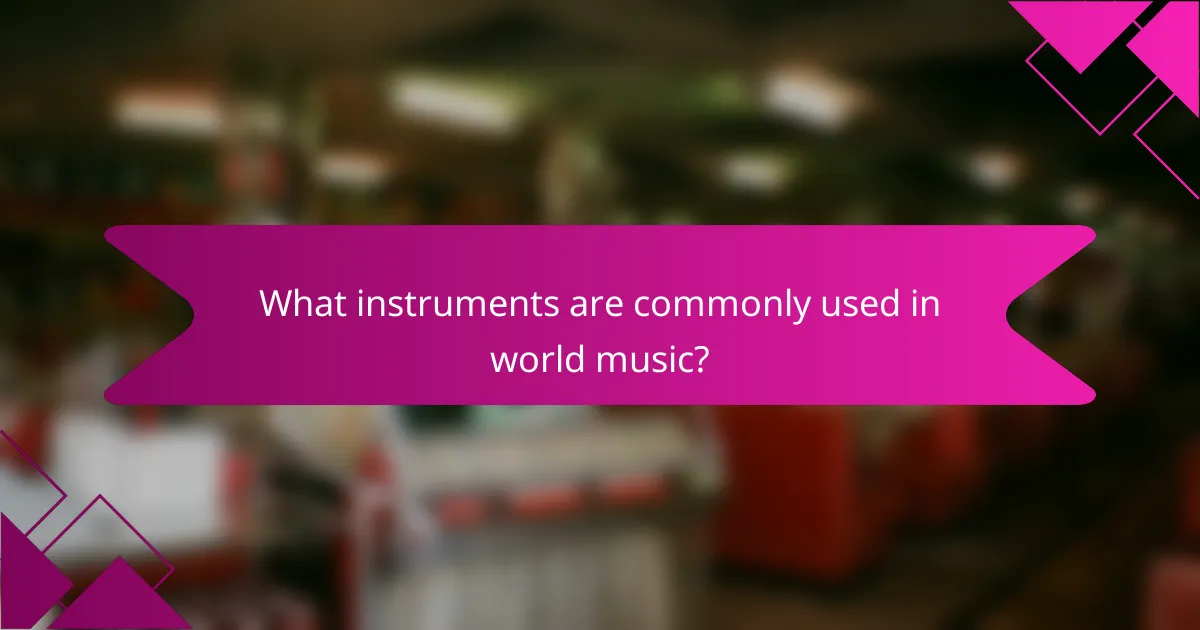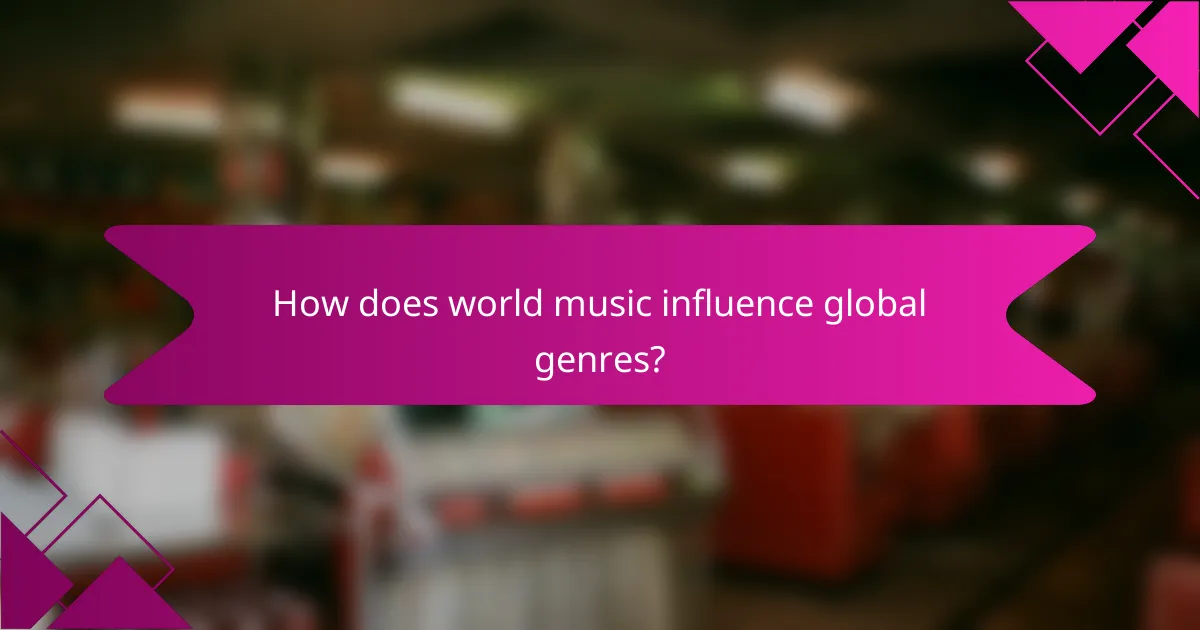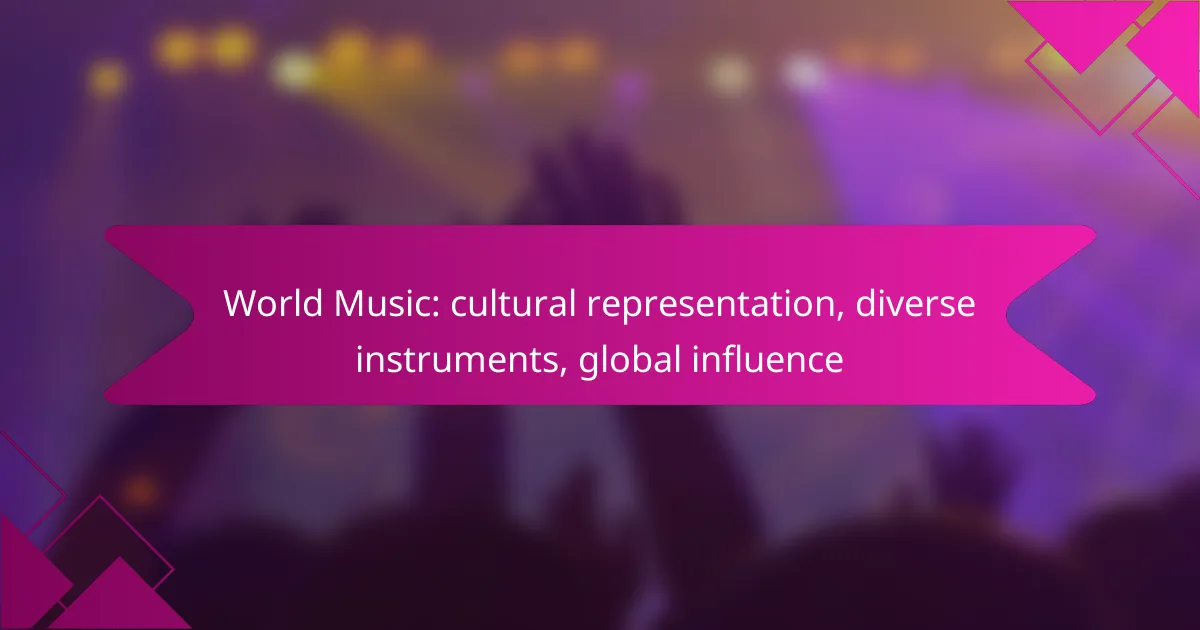World music serves as a vibrant tapestry that showcases the rich variety of cultural expressions across the globe. By incorporating unique instruments, rhythms, and melodies, it reflects the traditions and histories of diverse communities, while also influencing global musical genres through cross-cultural exchange.

How does world music represent diverse cultures?
World music serves as a vibrant tapestry that showcases the rich variety of cultural expressions across the globe. By incorporating unique instruments, rhythms, and melodies, it reflects the traditions, histories, and social contexts of different communities.
Influence of African rhythms
African rhythms are foundational to many musical genres worldwide, characterized by complex polyrhythms and syncopation. Instruments like the djembe and talking drum play a crucial role in traditional African music, often used in ceremonies and celebrations.
These rhythms have significantly influenced genres such as jazz, rock, and hip-hop, where artists often incorporate African beats to create a dynamic sound. Understanding these rhythms can enhance appreciation for their impact on contemporary music.
Asian traditional melodies
Asian traditional melodies often feature unique scales and modes that differ from Western music, creating distinct soundscapes. Instruments like the sitar, erhu, and shamisen bring rich textures and emotional depth to performances, reflecting cultural narratives and spiritual themes.
Genres such as Indian classical music and Chinese folk music emphasize improvisation and storytelling, allowing musicians to express personal and cultural identities. Exploring these melodies can deepen one’s understanding of Asia’s diverse cultural heritage.
Latin American dance styles
Latin American music is known for its infectious dance rhythms, such as salsa, tango, and samba, which embody the region’s vibrant culture. Instruments like the conga, maracas, and accordion are integral to creating lively and engaging performances.
These dance styles often reflect historical influences from African, Indigenous, and European traditions, showcasing a blend of cultural elements. Engaging with Latin American music can inspire participation in dance and foster appreciation for its cultural significance.
European folk traditions
European folk traditions encompass a wide range of musical styles that reflect local customs and histories. Instruments such as the fiddle, accordion, and bagpipe are commonly used in folk music, which often serves to tell stories or celebrate community events.
Each region has its unique folk music characteristics, from the Celtic tunes of Ireland to the polkas of Eastern Europe. Exploring these traditions can provide insights into the cultural identities and values of various European communities.

What instruments are commonly used in world music?
World music features a variety of instruments that reflect the cultural heritage and traditions of different regions. Commonly used instruments include string, percussion, and wind instruments, each contributing unique sounds and styles to the music of their respective cultures.
Guitar in Latin music
The guitar is a central instrument in many Latin music genres, including salsa, tango, and bossa nova. Its versatility allows it to be played in various styles, from rhythmic strumming to intricate fingerpicking.
In Latin music, the guitar often accompanies vocals and other instruments, providing harmonic support and enhancing the overall sound. Different types of guitars, such as the classical guitar and the cuatro, are used depending on the specific genre and regional influences.
Sitar in Indian classical music
The sitar is a prominent string instrument in Indian classical music, known for its distinctive sound and complex melodic capabilities. It typically features a long neck, a resonating body, and multiple strings, which allow for intricate improvisation.
In performances, the sitar is often accompanied by a tabla, creating a rich interplay of rhythm and melody. Musicians may use various techniques, such as slides and bends, to express the emotional depth of the music.
Djembe in West African music
The djembe is a goblet-shaped drum from West Africa, celebrated for its powerful, resonant tones. It is played with bare hands, allowing for a wide range of sounds, from deep bass notes to sharp slaps.
This instrument is central to many traditional West African music styles, often used in communal gatherings and celebrations. The djembe’s rhythms are typically polyrhythmic, encouraging participation and dance among listeners.
Didgeridoo in Australian Aboriginal music
The didgeridoo is a wind instrument developed by Indigenous Australians, known for its deep, drone-like sound. Traditionally made from eucalyptus branches hollowed out by termites, it is played by vibrating the lips while using circular breathing techniques.
In Aboriginal music, the didgeridoo accompanies songs and dances, often telling stories or connecting with the spiritual world. Its unique sound is integral to cultural ceremonies and celebrations, emphasizing the connection to the land and heritage.

How does world music influence global genres?
World music significantly shapes global genres by introducing diverse rhythms, instruments, and cultural narratives. This cross-pollination enriches musical styles, making them more vibrant and reflective of a broader human experience.
Impact on pop music
World music has transformed pop music by incorporating various cultural elements, leading to fresh sounds and innovative styles. For instance, Latin rhythms have become prevalent in mainstream pop, with artists like Shakira and J Balvin blending traditional sounds with contemporary beats.
Additionally, the use of instruments like the sitar or djembe in pop tracks adds unique textures that resonate with global audiences. This fusion not only broadens the appeal of pop music but also fosters cultural appreciation.
Integration in jazz
Jazz has long embraced world music, integrating diverse musical traditions to create new subgenres. Musicians often draw inspiration from African, Indian, and Middle Eastern music, incorporating their scales, rhythms, and improvisational techniques.
For example, artists like John Coltrane and Herbie Hancock have explored world music elements, leading to the development of jazz fusion. This integration allows jazz to evolve continuously while maintaining its core improvisational spirit.
Fusion with electronic music
The fusion of world music and electronic music has led to innovative genres that appeal to a wide range of listeners. Producers often sample traditional instruments and rhythms, creating a rich tapestry of sound that reflects global influences.
Artists such as Thievery Corporation and Bonobo exemplify this blend, using global sounds to enhance electronic music’s depth. This combination not only attracts diverse audiences but also promotes cultural exchange through music.

What are the key characteristics of world music?
World music is characterized by its incorporation of diverse cultural elements, unique instruments, and a variety of musical traditions from around the globe. It often blends traditional and contemporary styles, reflecting the rich tapestry of human expression across different societies.
Use of traditional scales
Traditional scales are fundamental to the sound of world music, as they provide a distinct tonal framework that varies by culture. For instance, many Middle Eastern and Indian music styles utilize microtonal scales, which include intervals smaller than a semitone, creating a unique auditory experience. In contrast, Western music typically relies on major and minor scales.
Understanding these scales can enhance appreciation and performance of world music. Musicians often experiment with these scales to create new compositions, blending them with modern genres while preserving their cultural essence.
Rhythmic diversity
Rhythmic diversity is a hallmark of world music, showcasing a wide range of time signatures and patterns that differ significantly from Western music’s common 4/4 time. African music, for example, frequently employs polyrhythms, where multiple contrasting rhythms are played simultaneously, creating a rich tapestry of sound.
Musicians can explore various rhythmic structures by listening to different cultural styles. For instance, Latin American music often features syncopation and complex beats, while traditional Asian music may incorporate cyclical rhythms that repeat over extended periods.
Vocal styles and techniques
Vocal styles in world music are incredibly varied, reflecting cultural practices and traditions. Techniques such as throat singing in Mongolian music or call-and-response patterns found in African traditions highlight the diversity of vocal expression. These styles often serve specific social or ceremonial purposes, enhancing the communal experience of music.
To appreciate these vocal techniques, listeners can attend live performances or explore recordings that emphasize traditional singing methods. Engaging with these styles can deepen understanding of the cultural contexts from which they arise, enriching the overall experience of world music.

How can digital products enhance the world music experience?
Digital products significantly enhance the world music experience by providing greater accessibility, educational opportunities, and immersive performances. Through streaming services, online courses, and virtual reality concerts, users can engage with diverse musical traditions from around the globe.
Streaming platforms for global access
Streaming platforms like Spotify, Apple Music, and YouTube Music offer vast libraries of world music, allowing users to explore genres from various cultures easily. These services often curate playlists that highlight regional sounds, making it simple to discover new artists and styles.
Many platforms also provide features such as personalized recommendations and social sharing, enhancing the listening experience. Users can connect with friends to share their favorite tracks or explore collaborative playlists that showcase global influences.
Online courses for learning instruments
Online courses on platforms like Udemy, Coursera, and MasterClass allow individuals to learn traditional instruments from different cultures. These courses often feature video tutorials, sheet music, and interactive assignments, making it easier for beginners to start playing.
Consider enrolling in courses that focus on specific instruments, such as the sitar, djembe, or didgeridoo. Many courses are designed for various skill levels, ensuring that both novices and experienced musicians can benefit from the instruction.
Virtual reality concerts
Virtual reality (VR) concerts offer an immersive way to experience live performances from artists around the world. Platforms like Oculus Venues and Wave provide users with the opportunity to attend concerts in a virtual setting, enhancing the sense of presence and engagement.
These VR experiences often include interactive elements, such as the ability to move around the venue or interact with other attendees. As technology advances, the quality and accessibility of VR concerts are expected to improve, making them an exciting option for music lovers seeking unique experiences.
